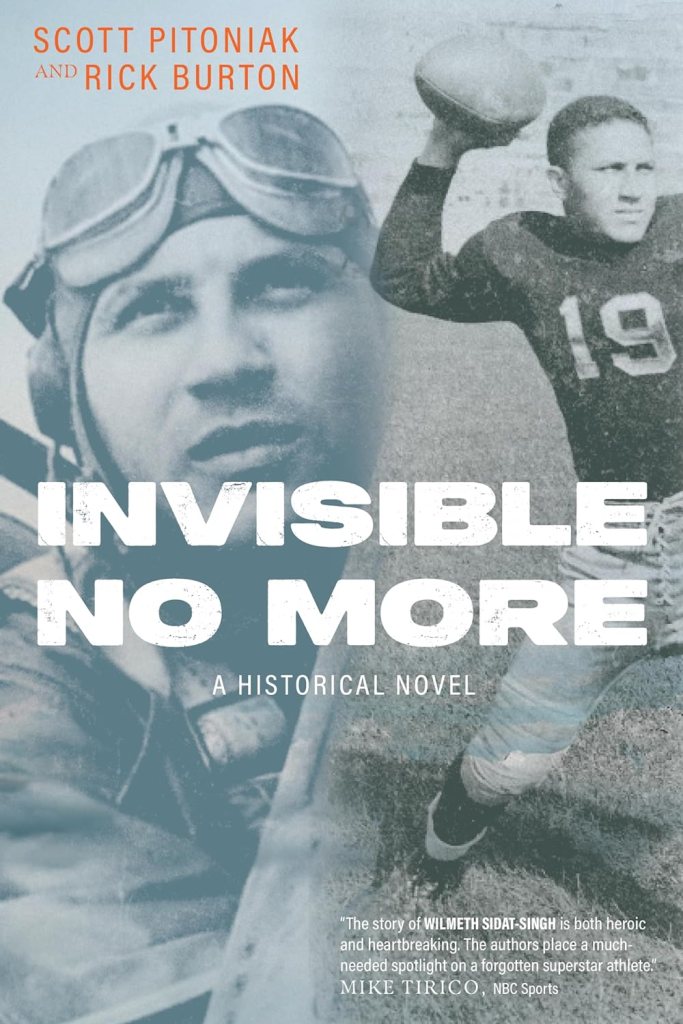Pitoniak, Scott and Burton, Rick. Invisible No More: A Historical Novel. Herndon, VA: Subplot Publishing, 2023. 319 pages. Price: Softcover $24.95. Ebook $9.99
Reviewed by Lisa Timpf

In Invisible No More: A Historical Novel, authors Scott Pitoniak and Rick Burton relate the life story of Syracuse University athlete Wilmeth Sidat-Singh. In the late 1930s, Sidat-Singh was “almost as celebrated as world heavyweight boxing champion Joe Louis and Olympic gold-medal sprinter Jesse Owens.” However, following his untimely death in 1943 at the age of 25, Sidat-Singh’s exploits were largely forgotten.
Sidat-Singh was a Black athlete who played university sports at a time when such activities were largely the preserve of white players. A football quarterback and All-American basketball star, Sidat-Singh stood out on the gridiron and the court. Authors Pitoniak and Burton describe him as “an athlete ahead of his time, who sadly was denied opportunities because of the times.”
Wilmeth’s father died when Wilmeth was seven years old. His mother re-married, having met Samuel Sidat-Singh through her job. Wilmeth took on his stepfather’s surname. As a result of Wilmeth’s last name, many in the media referred to him as being Indian or Hindu. It was a lie that “white sportswriters, coaches and officials created.” Sidat-Singh reluctantly went along with the mis-representation, having been told that “that’s the only way he’d be able to get his college education and continue playing sports in 1930s America.”
Ultimately, journalist Sam Lacy broke the story that Sidat-Singh was actually Black and not Hindu as many of the media had proclaimed. This revelation came just prior to a critical matchup between Syracuse University and the University of Maryland. University of Maryland, like some other schools, had an informal agreement with some Northern universities that Black players would not be used for games played south of the Mason-Dixon line. As a result, Wilmeth was benched for that critical matchup. This was just one of many incidents of racism that Wilmeth faced in his life and his athletic career.
After finishing university, Wilmeth volunteered to join the Tuskegee Airmen, a group of African American fighter and bomber pilots. Wilmeth’s enrolment in the program resulted in an increase in sign-ups, demonstrating his importance as a role model. Even though they’d enlisted to fight for their country, Wilmeth and his colleagues were again subjected to discrimination and adverse treatment during pilot training. Despite that, Wilmeth opted to remain in the program. He put his aspirations to become a doctor, and possibly a professional athlete, on hold until after the war.
Wilmeth never got the chance to pursue those goals. He died after his plane went down during a training mission in 1943. His full-honors burial at Arlington National Cemetery was “attended by luminaries such as Joe Louis and Cab Calloway,” highlighting the extent to which he was revered in the African American community.
In the book’s Afterword, the authors note that the story of Wilmeth Sidat-Singh is one that they had been working on for a quarter of a century. However, bringing Wilmeth’s story to light had its challenges. Sidat-Singh “was rarely quoted in the historically Black newspapers or in the mainstream white press.” There were no radio or television interviews to draw on. Wilmeth did not leave a diary, or letters. Research included delving into old newspapers, and talking to Wilmeth’s coaches, teammates, and fellow Tuskegee airmen.
Because of the difficulty in getting information from Wilmeth’s viewpoint, Pitoniak and Burton opted to tell Wilmeth’s story as historical fiction rather than non-fiction. Much of the material portraying Wilmeth’s thoughts and feelings had to be generated based on the authors’ best guess.
Pitoniak and Burton framed Invisible No More as a story of discovery, with a fictional female African American journalist named Breanna Shelton working to uncover and reveal the story of Wilmeth Sidat-Singh after coming across his name while covering a story about Charles Williams. In the novel, Williams, who served with Sidat-Singh as a member of the Tuskegee Airmen, recommended that Breanna look into Wilmeth’s story. Breanna is “a composite of several Black female reporters and editors” that the book’s authors got to know over the course of time. Her own encounters with sexism and racism in the book underscore the fact that these issues still exist, despite the passage of time since Wilmeth’s death, and her story provides resonance for Wilmeth’s experiences.
Portions of the book describe Breanna’s research into Sidat-Singh’s life, and her reactions when she learns about his exploits and the tribulations he had to overcome. Other parts of the book relate events in Wilmeth’s life as the authors imagine them, based on their research. The layering of Breanna’s and Wilmeth’s stories adds interest and suspense. Invisible No More is smoothly written, and I found myself drawn forward through the chapters.
Though Wilmeth Sidat-Singh’s exploits had been largely lost to time, the publication of Invisible No More seeks to address this. Other recent events have also served to bring Wilmeth’s story back to the forefront. In 2005, Wilmeth’s basketball jersey was retired by Syracuse University, and in 2013, in the “Forgiveness Game,” University of Maryland representatives “officially apologized to Wilmeth’s relatives for the school’s refusal to allow him to play seven decades earlier.”
Engagingly told, Invisible No More is an intriguing story about a talented athlete who was ahead of his time. Well worth a read.
